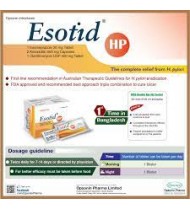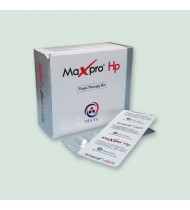Esomeprazole + Amoxicillin + Clarithromycin
Indications
This combination is indicated for the eradication of H. pylori in active chronic gastric, duodenal and gastric ulcers.
Pharmacology
Esomeprazole exerts its stomach acid-suppressing effects by preventing the final step in gastric acid production by covalently binding to sulfhydryl groups of cysteines found on the (H+, K+)-ATPase enzyme at the secretory surface of gastric parietal cells. This effect leads to inhibition of both basal and stimulated gastric acid secretion, irrespective of the stimulus. As the binding of esomeprazole to the (H+, K+)-ATPase enzyme is irreversible and new enzyme needs to be expressed in order to resume acid secretion, esomeprazole's duration of antisecretory effect that persists longer than 24 hours
Amoxicillin is similar to penicillin in its bactericidal action against susceptible bacteria during the stage of active multiplication. It acts through the inhibition of cell wall biosynthesis that leads to the death of the bacteria.
Clarithromycin acts by inhibiting microsomal protein synthesis in susceptible organisms mainly by binding to the donor site on the 50S subunit of the bacterial ribosome and preventing translocation to that site.
Amoxicillin is similar to penicillin in its bactericidal action against susceptible bacteria during the stage of active multiplication. It acts through the inhibition of cell wall biosynthesis that leads to the death of the bacteria.
Clarithromycin acts by inhibiting microsomal protein synthesis in susceptible organisms mainly by binding to the donor site on the 50S subunit of the bacterial ribosome and preventing translocation to that site.
Dosage & Administration
Each tablet twice daily for 7-14 days or as per the physician’s advice
Interaction
Esomeprazole is metabolized through the cytochrome P450 system, specially through the CYP3A isozymes. Studies have shown that Esomeprazole does not have clinically significant interactions with other drugs metabolized by the cytochrome P450 system, such as warfarin, antipyrine, indomethacin, ibuprofen, phenytoin, propranolol, prednisolone, diazepam, clarithromycin or terfenadine in healthy subject.
Clarithromycin use in patients who are receiving theophylline may be associated with an increase of serum theophylline concentrations.
There have been reports of interactions of clarithromycin with carbamazepine, cyclosporine, tactrolimus, hexobarbital, phenytoin, alfetanil, disopyramide, lovastatin, bromocriptine, valproate, terfenadine, cisapride, pimozide & astemizole.
Clarithromycin use in patients who are receiving theophylline may be associated with an increase of serum theophylline concentrations.
There have been reports of interactions of clarithromycin with carbamazepine, cyclosporine, tactrolimus, hexobarbital, phenytoin, alfetanil, disopyramide, lovastatin, bromocriptine, valproate, terfenadine, cisapride, pimozide & astemizole.
Contraindications
This is contraindicated in patients with known hypersensitivity to any of its component.
Side Effects
H. pylori eradication therapy is generally well tolerated. Adverse events reported during clinical trials were not unexpected given the component substances. Common adverse reactions included diarrhoea and nausea.
Pregnancy & Lactation
This should only be given to pregnant women if its use is considered essential. The safety of this combination for use during breast feeding of infants has not been established.
Precautions & Warnings
Serious and occasionally fatal hypersensitivity reactions have been reported in patients on Amoxicillin therapy. These reactions are more apt to occur in indivduals with a history of penicillin hypersensitivity. Clarithromycin should not used in pregnant women except in clinical circumstances where no alternative is appropriate.
Use in Special Populations
GERIATRIC USE: Although this regimen has not been specifically studied in the elderly, dosage adjustment is not needed during therapy with individual components. It is therefore unlikely to require dosage adjustment with this combination
Therapeutic Class
Anti H. pylori drugs
Storage Conditions
Store in a cool (below 30 degree C) and dry place.
Esotid HP Tablet 20 mg+1000 mg+500 mg
IndicationsThis combination is indicated for the eradication of H. pylori in active chronic gastric,..
55.00Tk.
Maxpro Hp Tablet 20 mg+1000 mg+500 mg
IndicationsThis combination is indicated for the eradication of H. pylori in active chronic gastric,..
55.00Tk.
Showing 1 to 2 of 2 (1 Pages)


